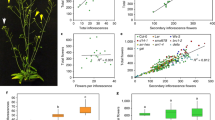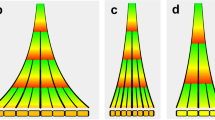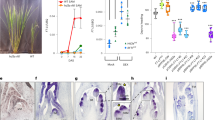Abstract
FROM experimental studies of phyllotaxis in flowering plants. M. and R. Snow1 concluded that the next leaf Primunordium to be formed will arise in the “next available space’ on the apical meristem, that is, tha first space or gap between existing primorditf that attains a certain minimum width and which is situated a certain distance below the extreme tip of the shoot. They showed that the position of the new primordium within a gap can be modified by experimental treatment and that it is determined by those primordia which abut on the gap and not by all the primordia of the top cycle. In comparable experiments with. Dryopteris aristata Druce, I obtained evidence which substantially supports these findings2. In ferns, an evident feature is that the newly formed primordium occupies only a small part of the interfoliar meristematic area. There is evidence that tensile stresses are induced in the fern apical meristem by the existing leaf primordia, new primordia typically arising in regions of minimal stress. Accordingly, it has been suggested that these stresses may determine, or define, the space in which the next primordium can be formed ; but that other factors are probably responsible for leaf formation2.
This is a preview of subscription content, access via your institution
Access options
Subscribe to this journal
Receive 51 print issues and online access
$199.00 per year
only $3.90 per issue
Buy this article
- Purchase on Springer Link
- Instant access to full article PDF
Prices may be subject to local taxes which are calculated during checkout
Similar content being viewed by others
References
Snow, M., and Snow, R., Phil. Trans. Roy. Soc., B, 221, 1 (1931); 223, 353 (1933); 225, 63 (1935); New Phyt., 46, 15 (1947).
Wardlaw, Ann. Bot., N.S., 11, 97 (1948); 13, 163 (1949).
Wardlaw, Phil. Trans. Roy. Soc., B, 233, 415 (1949).
Schoute, Réc. Trav. Bot. Néerl., 10, 153 (1913).
Richards, Symposium on Growth, S.E.B., No. 2 (Camb. Univ. Press, 1948).
Bünning, “Entwicklungs- und Bewegungs-Physiologie der Pflanze’ (Springer, Berlin, 1948).
Wardlaw, Ann. Bot., N.S., 7, 171 (1943).
Author information
Authors and Affiliations
Rights and permissions
About this article
Cite this article
WARDLAW, C. Phyllotaxis and Organogenesis in Ferns. Nature 164, 167–169 (1949). https://doi.org/10.1038/164167a0
Issue Date:
DOI: https://doi.org/10.1038/164167a0
This article is cited by
-
Experimental Investigation on Grinding Temperature of Ti–6Al–4 V Using Biomimetic Engineered Grinding Wheel
International Journal of Precision Engineering and Manufacturing-Green Technology (2019)
-
Towards an understanding of spiral patterning in the Sargassum muticum shoot apex
Scientific Reports (2017)
-
Study on the grinding temperature of the grinding wheel with an abrasive phyllotactic pattern
The International Journal of Advanced Manufacturing Technology (2017)
-
Optimal hash arrangement of tentacles in jellyfish
Scientific Reports (2016)
-
Modeling and analysis of dynamic cutting points density of the grinding wheel with an abrasive phyllotactic pattern
The International Journal of Advanced Manufacturing Technology (2016)
Comments
By submitting a comment you agree to abide by our Terms and Community Guidelines. If you find something abusive or that does not comply with our terms or guidelines please flag it as inappropriate.



